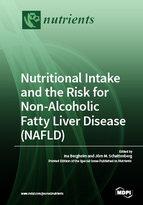Nutritional Intake and the Risk for Non-alcoholic Fatty Liver Disease (NAFLD)
A special issue of Nutrients (ISSN 2072-6643).
Deadline for manuscript submissions: closed (1 September 2018) | Viewed by 78006
Special Issue Editors
Interests: intestinal barrier; nutrition; bacterial endotoxin; alcoholic liver disease; non-alcoholic fatty liver disease
Special Issues, Collections and Topics in MDPI journals
Special Issue Information
Dear Colleagues,
The aim of this Special Issue focusing on “Nutritional Intake and the Risk of Non-Alcoholic Fatty Liver Disease” is to provide an in-depth overview of the role of the intake of different macro- and micronutrients in the development and progression of non-alcoholic fatty liver disease, as well as in the prevention and treatment of this metabolic liver disease. General over-nutrition but also alterations of the dietary pattern (e.g., towards a higher intake of fat, cholesterol, and sugar—and herein especially fructose) are discussed as being critical in the development of non-alcoholic fatty liver disease (NAFLD). However, it has also been suggested that a general reduction of caloric intake and/or modulation of dietary composition, be it in regards to fat or sugar intake, may have beneficial effects on liver status in settings of NAFLD. Furthermore, in more recent years the intake of pre- and probiotics but also specific micronutrients or secondary plant compounds also discussed a means in the prevention and therapy of this disease. Despite intense research efforts during the last decades, our understanding of the interaction of nutritional intake and the development but also prevention and cure of NAFLD is still limited.
Providing a better understanding of the effects of diet and herein especially of specific macro- and micronutrients as well as pre- and probiotics and secondary plant compounds in the context of the development of NAFLD and its progression could lead to novel prevention and therapeutic strategies for this metabolic liver disease. This Special Issue will thus include original research and scientific perspectives on the relationship between NAFLD and dietary constituents that may 1) be involved in the development of the disease and 2) prevent its onset and progression. Mechanistic insights defining the contribution of certain nutritional factors (e.g., macronutrients like fat and sugar but also micronutrients and secondary plant compounds as well as pre- and probiotics) to the occurrence and management of NAFLD will improve our understanding of the disease and eventually lead to the development of universally accepted prevention and therapeutic strategies.
Prof. Dr. Ina BergheimPD Dr. Jörn M. Schattenberg
Guest Editors
Manuscript Submission Information
Manuscripts should be submitted online at www.mdpi.com by registering and logging in to this website. Once you are registered, click here to go to the submission form. Manuscripts can be submitted until the deadline. All submissions that pass pre-check are peer-reviewed. Accepted papers will be published continuously in the journal (as soon as accepted) and will be listed together on the special issue website. Research articles, review articles as well as short communications are invited. For planned papers, a title and short abstract (about 100 words) can be sent to the Editorial Office for announcement on this website.
Submitted manuscripts should not have been published previously, nor be under consideration for publication elsewhere (except conference proceedings papers). All manuscripts are thoroughly refereed through a single-blind peer-review process. A guide for authors and other relevant information for submission of manuscripts is available on the Instructions for Authors page. Nutrients is an international peer-reviewed open access semimonthly journal published by MDPI.
Please visit the Instructions for Authors page before submitting a manuscript. The Article Processing Charge (APC) for publication in this open access journal is 2900 CHF (Swiss Francs). Submitted papers should be well formatted and use good English. Authors may use MDPI's English editing service prior to publication or during author revisions.
Keywords
- Nutrition
- Dietary pattern
- Metabolism
- Intestinal barrier and microbiota
- Non-alcoholic fatty liver disease
- Non-alcoholic steatohepatitis
- Macronutrients
- Micronutrients
- Secondary plant compounds
- Prebiotics
- Probiotics








